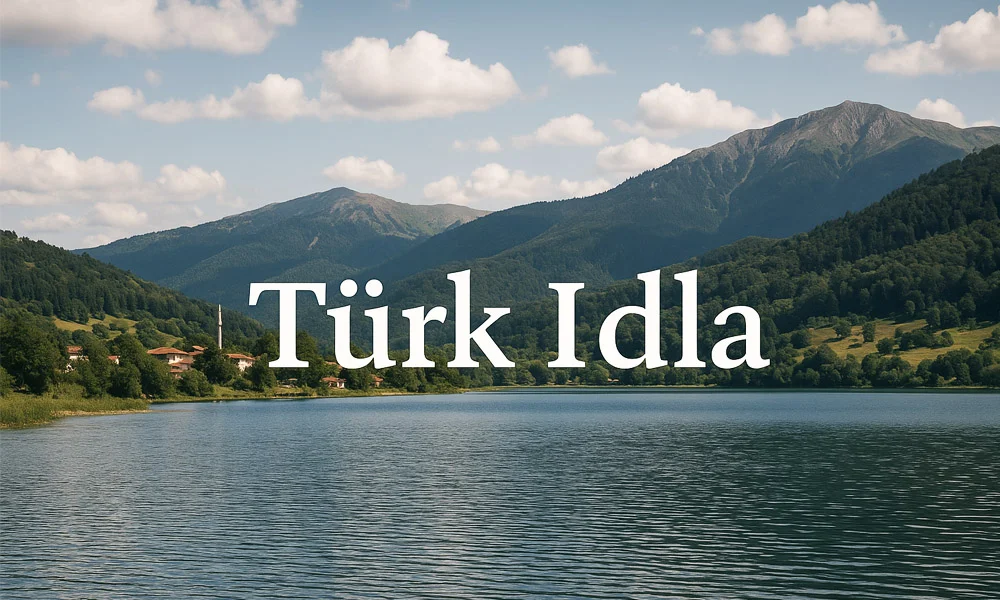In the vast and ever-evolving digital landscape, new cultural identities are constantly forming — some fade quickly, while others shape the next generation’s worldview. One such concept gaining quiet but significant traction is Türk Idla, a term that captures the evolving spirit of Turkish identity as it moves through tradition, technology, and transformation.
At its heart, Türk Idla represents a modern synthesis of heritage and innovation, merging the timeless values of Turkish culture with the boundless creativity of the digital world. But what exactly is Türk Idla? Why is it suddenly attracting global curiosity? And how does it bridge the ancient and the modern? Let’s take a deep dive.
1. Understanding the Essence of Türk Idla
The phrase “Türk Idla” may sound new, but its essence is anything but. Linguistically, “Türk” represents Turkish identity, while “Idla” (derived from various interpretations of “ideal,” “idol,” or “essence”) signifies purity, expression, or individuality. When combined, the term evokes “the authentic Turkish spirit”—a blend of cultural integrity, creativity, and self-expression.
Türk Idla, in this sense, isn’t a movement born in classrooms or politics—it’s an organic expression of identity emerging from Turkish creators, thinkers, artists, and youth who use digital spaces to redefine what being Turkish means in the 21st century.
It’s not nationalism in the traditional sense, nor is it blind modernization. Türk Idla stands somewhere in between — a new lens for understanding how Turkish culture evolves without losing its roots.
2. Historical Foundations: From Nomadic Tribes to the Digital Frontier
To grasp Türk Idla’s cultural weight, one must first trace the deep historical currents that shaped Turkish identity.
From the Central Asian steppes, early Turkic tribes brought with them an ethos of resilience, honor, and adaptability. These qualities later merged with Persian sophistication, Arab philosophy, and Anatolian warmth during the Seljuk and Ottoman eras, creating a tapestry of values that still define Turkish life today: hospitality, courage, family, artistry, and community.
However, the modern world introduced new dynamics. After the Republic of Turkey was established in 1923, rapid modernization and Western influence began reshaping cultural norms. While Turkey embraced progress, many felt that something uniquely “Turkish” risked being diluted.
That’s where Türk Idla steps in — as a response to cultural fragmentation, offering a way for younger generations to reinterpret ancient identity through modern expression. Whether through art, fashion, digital content, or music, Türk Idla is the 21st-century reincarnation of centuries-old Turkish spirit.
3. The Digital Generation and the Rise of Türk Idla Creators
The past decade has seen a remarkable transformation in how identity is expressed. Platforms like TikTok, YouTube, and Instagram have given millions of young Turks an unprecedented voice.
Unlike traditional celebrities shaped by TV and cinema, Türk Idla creators emerge from their bedrooms, laptops, and cameras. They are storytellers, musicians, illustrators, coders, and vloggers who turn everyday life into a form of cultural expression.
These creators do more than entertain—they reinterpret heritage. A young woman in İzmir might remix a folk melody into electronic beats; a designer in Ankara could reimagine Ottoman motifs in streetwear; a YouTuber in Istanbul might document forgotten Anatolian crafts.
Each of these actions represents Türk Idla—an active, creative reclaiming of Turkishness in a globalized world.
Rather than rejecting global influence, Türk Idla artists remix it. They don’t see Western culture as competition but as a language through which they can amplify their own identity.
4. Türk Idla and the Aesthetic of Authenticity
One striking element of Türk Idla culture is its aesthetic—the visual and emotional tone it carries. It’s minimalist yet soulful, modern yet nostalgic.
Scroll through the Instagram feed of a Türk Idla creator and you’ll notice a recurring theme: the fusion of old and new. Vintage carpets meet neon lighting. Calligraphic art coexists with 3D animation. Traditional Turkish coffee cups rest beside MacBooks.
This aesthetic is not accidental—it reflects the tension between memory and modernity that defines the Turkish experience.
For a generation that feels both deeply connected to their heritage and fully immersed in global technology, Türk Idla offers an aesthetic language to balance both worlds.
It’s not about looking Turkish; it’s about feeling Turkish in a global context.
5. The Philosophy Behind Türk Idla
Beyond its visual charm, Türk Idla carries a subtle philosophy. It is rooted in self-discovery through cultural belonging.
In a time when digital platforms often encourage conformity, Türk Idla stands for authentic individuality within collective identity. It asks: how can one remain true to their roots while embracing global influences?
The answer lies in creative self-expression grounded in values like:
- Hospitality – openness to ideas and people.
- Respect – for elders, heritage, and craft.
- Adaptability – evolving without erasing the past.
- Unity – finding common ground amidst diversity.
- Artistry – expressing the soul through creation.
These principles aren’t dictated by institutions but lived through everyday digital creativity. Türk Idla, in this sense, becomes a cultural compass guiding Turkish youth through an era of cultural disconnection.
6. The Societal Impact of Türk Idla
Türk Idla is not limited to social media—it’s influencing fashion, design, education, and even small business culture in Turkey.
- In fashion, brands are drawing on Turkish textile heritage, patterns, and symbols while adopting sustainable and modern production methods.
- In design, architects and interior artists are reintroducing traditional Anatolian geometry and materials into contemporary spaces.
- In education, educators encourage students to explore Turkish history, crafts, and digital storytelling to maintain cultural awareness.
- In entrepreneurship, young Turkish innovators are branding local goods—coffee, ceramics, digital art—as modern expressions of Turkish excellence.
Türk Idla thus becomes a bridge between culture and economy, enabling Turkey to project soft power through its creativity, not just its history.
7. Challenges Facing the Türk Idla Movement
Every cultural movement faces resistance, and Türk Idla is no exception.
The most pressing challenge is misunderstanding—some dismiss it as superficial or elitist, while others fear it may dilute traditional values.
There’s also the issue of digital exploitation: creators struggle with algorithms, copyright violations, and monetization barriers. For a movement built on authenticity, navigating the commercial side of social media is complex.
Moreover, Türk Idla must constantly balance between pride and inclusivity. True cultural confidence comes not from isolation but from openness—and that’s what the movement must sustain.
8. Türk Idla in Global Context
What makes Türk Idla particularly fascinating is its universal resonance. Similar cultural reawakenings have appeared elsewhere: K-pop in Korea, Harajuku in Japan, Afrofuturism in Africa and the diaspora.
Yet Türk Idla stands apart for its emphasis on subtlety and soulfulness rather than spectacle.
It doesn’t aim to conquer global trends but to enrich them. In the same way Turkish coffee invites slow reflection, Türk Idla invites a slower, deeper kind of cultural exchange. It’s less about viral fame and more about creating emotional connection through identity.
9. The Future of Türk Idla
Where is Türk Idla headed?
Experts and digital analysts predict that Turkish cultural expression online will only grow. The next decade will likely see Türk Idla expanding into:
- Virtual art spaces and NFTs that feature Turkish motifs.
- AR/VR cultural storytelling bringing Anatolian legends to digital life.
- Cross-cultural collaborations between Turkish creators and international artists.
- Educational platforms teaching Turkish art, music, and design to global audiences.
In the long run, Türk Idla could evolve into a cultural brand of Turkey’s digital era, much like how “Cool Japan” became a cultural export of Japanese innovation.
10. Why Türk Idla Matters Today
In an age where global culture often blurs local identity, Türk Idla matters because it reclaims cultural pride without hostility.
It shows that being proudly Turkish doesn’t mean rejecting modernity—it means defining modernity on Turkish terms.
The world doesn’t need uniform culture; it needs diversity with confidence. Türk Idla embodies that philosophy: a generation saying, “We can be global and still be ourselves.”
11. Türk Idla as a Mirror of Youth and Hope
Perhaps the most touching aspect of Türk Idla is its emotional depth.
Behind every photo, song, or post tagged under Türk Idla lies a yearning—to belong, to express, to connect. For many Turkish youth, it’s not just about fame or aesthetics; it’s about rediscovering identity in an overwhelming digital ocean.
Türk Idla offers that anchor. It tells them: Your voice matters. Your heritage matters. Your future can coexist with your past.
12. Critics and Counterarguments
Of course, no cultural trend is above critique. Some scholars argue that Türk Idla might oversimplify Turkish identity or turn it into a brand. Others claim it’s an online illusion disconnected from real-world cultural issues like rural decline, education, or economic inequality.
These critiques are valid, but they also miss the larger picture. Türk Idla isn’t meant to solve structural problems; it’s meant to reignite cultural imagination. When young people feel proud of their roots, they’re more likely to build, create, and engage with society.
13. Türk Idla and the Power of Storytelling
Stories are the heartbeat of Türk Idla. Whether it’s a grandmother’s folktale retold on TikTok, a short film inspired by Ottoman love poetry, or a podcast about Turkish proverbs—each story breathes life into this evolving identity.
This storytelling doesn’t follow rigid rules. It can be humorous, melancholic, or experimental. The point is not perfection, but connection—between generations, between Turkey and the world, between tradition and technology.
14. Türk Idla Beyond Borders
Interestingly, Türk Idla is not confined to Turkey’s borders. Turkish communities in Germany, the Netherlands, the UK, and the US have started using similar aesthetics to express dual identity.
For second-generation Turks abroad, Türk Idla represents a bridge home—a way to celebrate their heritage while thriving in global cultures.
In this sense, Türk Idla transcends geography. It becomes a diasporic identity, binding Turkishness across continents through creativity and digital art.
15. The Legacy in Progress
Türk Idla is still young, still forming, still searching for its ultimate expression. But every movement begins with a whisper before it becomes a voice.
What makes Türk Idla special is its authenticity—it’s not driven by corporations or governments but by individual creators with collective spirit. It thrives on curiosity, empathy, and pride.
As technology advances, Türk Idla might become one of Turkey’s defining cultural exports — not as a product, but as an idea: that identity can evolve without erasing history.
Conclusion
Türk Idla is more than a trend—it’s a living dialogue between past and future, tradition and technology, self and society. It proves that cultural identity isn’t static; it’s dynamic, adaptable, and capable of flourishing in digital soil.
By embracing Türk Idla, Turkey’s new generation isn’t abandoning its roots—it’s watering them with creativity, ensuring they grow toward the light of the future.
Whether you’re a digital artist, a historian, or simply someone proud of your heritage, Türk Idla invites you to join that conversation—to rediscover who you are, and to share it with the world.
FAQs
1. What does “Türk Idla” mean?
It roughly translates to “the Turkish essence” or “the spirit of Turkish identity,” combining heritage and creativity in a modern context.
2. Is Türk Idla a social movement or just an online trend?
It’s both a digital trend and a cultural movement—an evolving space where Turkish creators express identity through art, design, and storytelling.
3. Who are the main figures behind Türk Idla?
There’s no single founder. Türk Idla is a collective expression led by independent artists, influencers, and youth creators in Turkey and abroad.
4. How does Türk Idla differ from traditional Turkish culture?
While rooted in tradition, Türk Idla adapts cultural elements for digital platforms, blending old aesthetics with new technologies.
5. Can non-Turkish people engage with Türk Idla?
Absolutely. Türk Idla celebrates Turkish identity but welcomes anyone who appreciates cultural creativity and authenticity.

